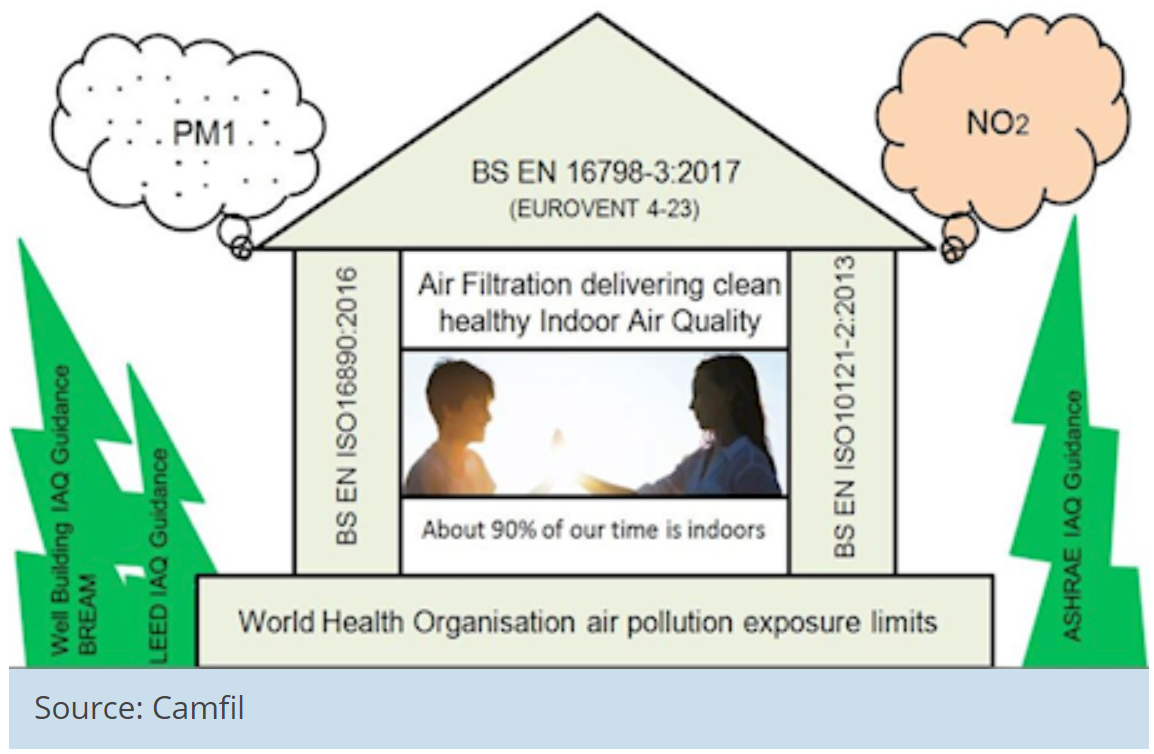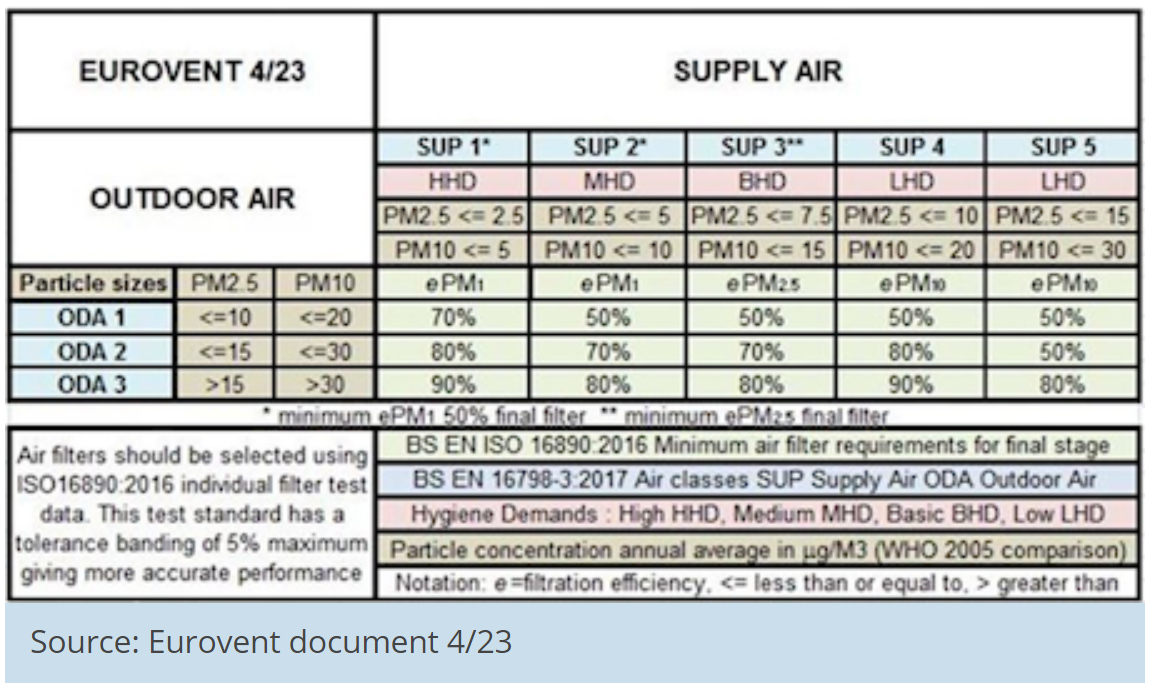Air filtration and clean indoor air quality standards
There have been many recent changes in the British, European and World technical standards relating to clean indoor air quality and the air filter performance testing. New standards have been developed in response to the need to breathe clean healthy air by occupants of city buildings.
The need for clean air that can be inhaled without risk to health does not change whether inside or outside a building. However outside air in UK cities has been a cause for concern for many years. This concern has mainly centred around the high levels of traffic air pollution in the form of fine combustion particles (PM1, PM2.5) and the associated combustion gas nitrogen dioxide (NO2). There are a large number of medical studies giving details of the negative health effects of exposure to these and other outdoor sourced air pollutants.
The World Health Organization (WHO) publish annual mean exposure limits for fine PM particles and gases such as NO2 that are hazardous to health. This is useful because these limits can be used to define and classify how clean or polluted air is in respect of these air pollutants.
Ventilation of city buildings is a normal requirement when occupied by people. Outside air must be drawn into the building to reduce the inside level of carbon dioxide, a waste gas produced by people. This supply air, as it is called, needs to be cleaned of PM1, PM2.5 particles and of nitrogen dioxide. Once this is done the outside air can be introduced into the building diluting and ultimately displacing the inside air along with its pollutants.
Air pollution, as mentioned before, comes in two different forms, namely particles and gases. There are two different types of air cleaning filters to deal with them and there is a technical standard for each. The current relevant standards are as follows:
- BS EN ISO 16890:2016 is the global performance test standard for particle filters (PM1, PM2.5). It has been designed to replace BS EN 779:2012 which was withdrawn in June 2018 and the ASHRAE 52.2 US standard. These earlier standards were comparative filter tests only and should not be considered as representative of real-life performance.
- BS EN ISO 10121-2:2013 is the Global performance test standard for molecular gas filters (NO2, but also SO2, O3, H2S, VOCs, Aldehydes).
- BS EN 16798-3:2017 is the European technical standard that defines and categorises outside air and building air using WHO pollutant exposure limits combined with a factor to show how clean air is inside and outside of the building. For outside air pollution levels, categories ODA1 ODA2 ODA3 are defined and for inside air pollution IDA is used. For supply air filtered by the ventilation air system categories SUP1 to SUP5 are defined.
Another useful source of guidance is the EUROVENT 4/23 (2018) document from the European ventilation manufacturers association that gives detailed applications and building function recommendations for clean air SUP levels.
Indoor sourced air pollution is also present and needs to be considered. The most encountered indoor air pollutants are gaseous Volatile Organic Compounds (VOCs) and Aldehydes such as Formaldehyde (CH2O). Organic gases and odours may also be a problem and, in certain areas of the UK Radon, a radioactive gas can find its way into basement areas from bedrock below.
Indoor sourced particles tend to be larger sized and of a biological nature such as mould spores, skin flakes and expelled aerosols. They can harbour bacteria and be infective which is of greatest concern in hospitals and healthcare facilities or schools.
The health issues relating to airborne combustion particles largely stem from their small size and therefore their capability to penetrate the human body. If these particles are also toxic or of chemically damaging nature they have a double jeopardy.
The new air filter standards BS EN ISO 16890:2016 and BS EN ISO 10121-2:2013 have easy to understand filter performance classification; simply the particle size or pollutant gas range, followed by the removal efficiency.
For example, in the performance classification ePM1 85%, 'e' denotes filtration efficiency, 'PM1 is the particle size range and 85% is the tested removal efficiency for PM1. Because this performance is easy to understand, HVAC air filter performance is now transparent and understandable to the end user.
As a guideline ePM1 rated air filters should be used as a minimum for all city located buildings occupied by people.
If low energy air filters are used (Eurovent A or A+ rated) not only pollution but also costs can be minimized. It is however worth noticing, that both can only be achieved at the continuous, desired level if regular maintenance of the filters is ensured.
The same type of analysis applies to molecular gas filter efficiency to reduce nitrogen dioxide levels (NO2).
Using the latest technical standards mentioned above, it is possible to calculate the required air filter efficiency, with accuracy, by knowing the inside and outside levels of air pollution for the building under consideration. For example, local air monitoring data for levels of air pollutant of concern can be measured directly or even found by looking at local authority air monitoring stations. In London for example, King’s College have a historic database and map presenting annual mean levels for several air pollutants of concern.
The table below, extracted from Eurovent document 4/23 provides information about categories performance for each of the standards (use colour coding for guidance)
An inside/outside ratio of air pollution concentrations will give the required air filter efficiency which will be usually about 80% to 90% for most large city locations such as London. This will show a reduction from ODA3 (over 1.5x WHO limit) down to SUP2 (under 0.5x WHO limit) typically.
We are entering an age where we can control our environment at home and work by measuring and monitoring clean air and removing air pollution so that we can breathe without risk to health and with benefit to wellbeing and performance.
The latest technical standards for the air cleaning products give us ability to protect ourselves with effective solutions. Let’s use them.
References
- BS EN ISO 16890:2016 Particle filter performance testing
- BS EN ISO 10121-2:2013 Molecular gas filter performance testing
- BS EN 16789-3:2017 Energy in buildings (IAQ and filtration)
- Eurovent 4/23 2nd Ed.(Oct 2018)
- World Health Organization (WHO) Air pollution report 2005
- Royal College of Physicians (RCOP) report 'Every breathe' 2016
- King’s College London - AQ Map and monitored air pollution data.
This article was originally published as ‘New air filtration and clean Indoor Air Quality Standards. An important step forward to improve control of air quality in buildings’ by BSRIA in February 2020. It was written by Peter Dyment.
--BSRIA
[edit] Related articles on Designing Buildings
- Air filtration.
- Air pressure drop APD.
- BSRIA.
- Clean indoor air for healthy living - New air filter standards.
- BREEAM Indoor air quality plan.
- BREEAM Indoor air quality Ventilation.
- BREEAM Indoor pollutants VOCs.
- BSRIA articles on Designing Buildings Wiki.
- Air permeability in isolation rooms.
- Air Quality Taskforce.
- At a glance - Indoor air quality.
- BREEAM extends coverage of VOC schemes to a number of European-based schemes.
- Bringing a breath of fresh air to the design of indoor environments.
- BSRIA responds to UK Air Pollution Report.
- Designing HVAC to resist harmful microorganisms.
- Effective ventilation in buildings.
- Fresh air.
- Health effects of indoor air quality on children and young people.
- High efficiency particulate arrestance HEPA.
- Indoor air quality.
- Indoor environmental quality.
- MedicAir air purification technology.
- UV disinfection of building air to remove harmful bacteria and viruses.
Featured articles and news
Infrastructure that connect the physical and digital domains.
Harnessing robotics and AI in challenging environments
The key to nuclear decommissioning and fusion engineering.
BSRIA announces Lisa Ashworth as new CEO
Tasked with furthering BSRIA’s impressive growth ambitions.
Public buildings get half a million energy efficiency boost
£557 million to switch to cleaner heating and save on energy.
CIOB launches pre-election manifesto
Outlining potential future policies for the next government.
Grenfell Tower Inquiry announcement
Phase 2 hearings come to a close and the final report due in September.
Progress from Parts L, F and O: A whitepaper, one year on.
A replicated study to understand the opinion of practitioners.
ECA announces new president 2024
Electrical engineer and business leader Stuart Smith.
A distinct type of countryside that should be celebrated.
Should Part O be extended to existing buildings?
EAC brands heatwave adaptation a missed opportunity.
Definition of Statutory in workplace and facilities management
Established by IWFM, BESA, CIBSE and BSRIA.
Tackling the transition from traditional heating systems
59% lack the necessary information and confidence to switch.
The general election and the construction industry
As PM, Rishi Sunak announces July 4 date for an election.
Eco apprenticeships continue help grow green workforce
A year after being recognised at the King's coronation.
Permitted development rights for agricultural buildings
The changes coming into effect as of May 21, 2024.
























